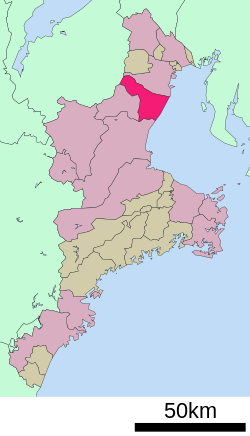Suzuka(Linh lộc thị,Suzuka-shi)is acityinMie Prefecture,Japan.As of 31 July 2020[update],the city had an estimatedpopulationof 197,977 in 87,680 households and apopulation densityof 1000 persons per km².[1]The total area of the city is 194.46 square kilometres (75.08 square miles).
Suzuka
Linh lộc thị | |
|---|---|
 Suzuka City Office | |
 Location of Suzuka in Mie Prefecture | |
| Coordinates:34°52′55.1″N136°35′3″E/ 34.881972°N 136.58417°E | |
| Country | Japan |
| Region | Kansai |
| Prefecture | Mie |
| Government | |
| • Mayor | Noriko Suematsu (since May 2011) |
| Area | |
| • Total | 194.46 km2(75.08 sq mi) |
| Population (August 2020) | |
| • Total | 197,977 |
| • Density | 1,000/km2(2,600/sq mi) |
| Time zone | UTC+9(Japan Standard Time) |
| - Tree | Japanese zelkova |
| - Flower | Satsuki azalea |
| Phone number | 059-382-1100 |
| Address | 1-18-18 Kanbe, Suzuka-shi, Mie-ken 513-8701 |
| Website | Official website |
Geography
editSuzuka is in northeastern Mie Prefecture, in northernKii Peninsula,bordered byIse Bayto the east. Parts of the city are within the borders of theIse-no-Umi Prefectural Natural Parkand theSuzuka Quasi-National Park.
Neighboring municipalities
editMie Prefecture
Shiga Prefecture
Climate
editSuzuka has ahumid subtropical climate(KöppenCfa) characterized by warm summers and cool winters with light to no snowfall. The average annual temperature in Suzuka is 15.6 °C. The average annual rainfall is 1737 mm with September as the wettest month. The temperatures are highest on average in August, at around 27.0 °C, and lowest in January, at around 4.7 °C.[2]
Demographics
editThe population of Suzuka has more than doubled over the 50-year period 1960-2010.[3]
| Year | Pop. | ±% |
|---|---|---|
| 1960 | 96,822 | — |
| 1970 | 121,185 | +25.2% |
| 1980 | 156,250 | +28.9% |
| 1990 | 174,105 | +11.4% |
| 2000 | 186,151 | +6.9% |
| 2010 | 199,184 | +7.0% |
History
editSuzuka, as a place name, is mentioned in theNara periodchronicleNihon Shoki.The ancientTōkaidōpassed through Suzuka, and the Nara-periodprovincial capitalwas within its borders. During theSengoku period,the area was controlled byOda Nobutaka,the third son ofOda Nobunaga,who ruled fromKanbe Castle.During theEdo period,much of the area was under the control of the 15,000kokuKanbe Domain,ruled by theHonda clanfrom 1732 until theMeiji restorationin 1871. During this period, twopost stationswere within the modern city limits:Ishiyakushi-jukuandShōno-juku,which prospered due to pilgrimage traffic to theIse Grand Shrine.
After the start of theMeiji period,the area was organized as part ofSuzuka Districtin 1889 and the town of Kanbe was established with the creation of the modern municipalities system on April 1, 1889. On December 1, 1942, Kanbe merged with the villages of Shirako, Inau, Iino, Kawano, Ichinomiya, Mida, Tanagaki, Wakamatsu, Ko, Shono, Takatsuse, Makita, and Ishiyakushi to form the city of Suzuka. The city further expanded in 1954 by annexing the villages of Sakae, Amana and Aikawa and portions of neighboring Kameyama.
Government
editSuzuka has amayor-councilform of government with a directly elected mayor and aunicameralcity council of 32 members. Suzuka contributes four members to the Mie Prefectural Assembly. In terms of national politics, the city is part of Mie 2nd district of thelower houseof theDiet of Japan.
Economy
editSuzuka boasts a significant industrial market, having major factories forSharpandHondain its bounds. These companies outsource part of their labor to South American nationals to secure a contract-based workforce.
Although the Japanese government encourages mandatory English-language education across the nation, in Suzuka many courses are offered by private cram schools (juku) and by publicly funded institutions supportingPortugueseandSpanish.In a controversial move, the city's governing body, from April 2004, requires all garbage information and local signage to be in Japanese and Portuguese (but not English).
Education
editColleges and universities
edit- Suzuka International University
- Suzuka Junior College
- Suzuka National College of Technology
- Suzuka University of Medical Science
Primary and secondary education
editSuzuka has 30 public elementary schools and ten public middle school operated by the city government, and five public high schools operated by the Mie Prefectural Department of Education. There are also one private middle school and one private high school, and the prefecture also operates one special education school for the disabled.
International schools
edit- International schools:Escola Alegria de Saber(エスコーラ・アレグリア・デ・サベール) -Brazilian school[4]Formerly Suzuka had another Brazilian school: Escola Sol Nascente.[5]
Transport
editRailway
editHighway
editLocal attractions
edit- Ise Kokubun-jiruins, National Historic Site
- Ise Kokufuruins, National Historic Site
- Ōzuka Kofun,National Historic Site
Sports
edit- Mie Honda Heat– rugby club
- Atletico Suzuka Club– association football club
Motor racing circuit
editSuzuka Circuitis a Honda-owned racetrack. It has been the home of theJapanese Grand Prixfrom 1987, except in 2007, 2008, 2020 and 2021. It is the only figure-eight circuit in the championship, and is very popular with the drivers, in spite of its numerous difficult bends. Located next to the circuit is the Honda Safety Riding/Driving School, where thousands of car and motorcycle drivers have been trained, including many police officers and instructors throughout the world.
Sister cities
edit- Le Mans,Maine,France,since May 27, 1990[6]
- Bellefontaine, Ohio,United States, since August 7, 1991
Notable people
edit- Miwa Asao,beach volleyball player
- Hideo Fukuyama,racing driver
- Reo Hatate,professional footballer
- Eisuke Nakanishi,professional soccer player
- Takafumi Ogura,professional soccer player
- Saitō Ryokuu,Meiji period author
- Sumie Sakai,professional wrestler
- Nobutsuna Sasaki,author, poet
- Nobuhide Tachi,racing driver
- Keisuke Tanimoto,professional baseball player
References
edit- ^"Suzuka city official statistics"(in Japanese). Japan.
- ^Suzuka climate data
- ^Suzuka population statistics
- ^"Escolas Brasileiras Homologadas no Japão"(Archive). Embassy of Brazil in Tokyo. Retrieved on October 13, 2015.
- ^"Escolas Brasileiras Homologadas no Japão"(Archive). Embassy of Brazil in Tokyo. February 7, 2008. Retrieved on October 13, 2015.
- ^"International Exchange".List of Affiliation Partners within Prefectures.Council of Local Authorities for International Relations (CLAIR).Retrieved21 November2015.
External links
edit- Official website(in Japanese)


